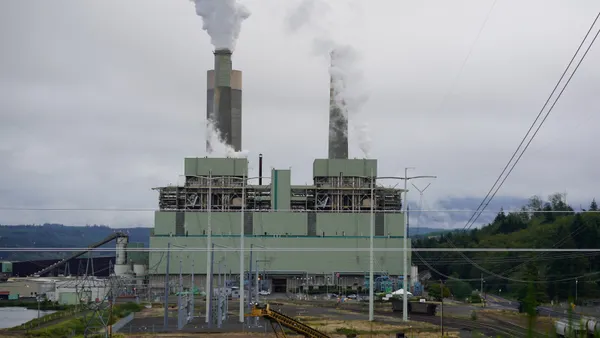Dive Brief:
- There will be 8.5 GW of new storage added to the U.S. grid by the end of 2021, and another 2 GW annually through 2025, according to new estimates from S&P Global Market Intelligence. Storage projects paired with renewable energy could see the strongest growth due to tax credits, falling development costs and the potential for higher gas prices.
- These "hybrid economics are driving new storage build into a greater proportion of markets than we'd previously forecast," Steve Piper, director of energy research with S&P, said Wednesday during a presentation of the firm's Q4 Power Forecast.
- The growth of new storage resources is helping to fuel the electric transition, but Piper also said that S&P expects the generation market share for zero-carbon resources to increase only "marginally" from 2021 to 2035, from 39% to 47%.
Dive Insight:
Energy markets appear ready to put 2020 behind them, according to S&P's Power Forecast.
The turmoil of the past year "put a lot of development activity in the generation space on pause," Piper said. While COVID-19 remains an active threat, "the market has assessed there is enough line of site to the pandemic's end, or its drawing down, to get on with fleet transformation and decarbonization of the electric sector."
There was little energy legislation at the federal or state level last year, after what Piper called "a huge flurry of activity in 2019" around renewable portfolio standards (RPS), carve-outs and procurement targets. The industry also saw delays in projects and contracting, which S&P attributes to economic uncertainty brought on by the pandemic.
But looking at the last quarter of 2020, Piper also said it "appeared a lot of the activity bottled up during the first half of the year resumed more or less in full force, concentrated in the newer asset classes of renewable energy and also storage in hybrid and standalone configurations."
S&P expects the California ISO market to add 750 MW of storage annually, through 2025. PJM Interconnection and the Electric Reliability Council of Texas (ERCOT) territories could add 350 MW each, annually for five years. Across those same timeframes, grid operators in New York and New England could add 325 MW annually.
Improving economics has made solar+storage projects competitive in markets where S&P previously believed conventional peaking generation had prevailed, Piper said.
"We forecast renewable generation will increase more rapidly than demand growth" through 2035, said Piper, "which is really a necessary precondition for rapid decarbonization."
Despite the addition of new resources, Piper said S&P forecasts "only a marginal improvement in the market share of carbon-emissions free generation, even with cheaper storage optimizing renewables and bringing still more solar to the market." That's in part because a doubling of wind and solar market share will be offset by declines in hydro and nuclear generation.
There is general optimism for zero-carbon policies, with President Biden now in the White House. But it also means policymaker and lawmakers must continue advancing clean energy policies, said Piper.
Decarbonization "will require specific policy commitments, such as passage of the clean electric standard the Biden admin proposed, or a doubling down on RPS commitments at state level," Piper said.
The outlook in ERCOT
Looking to Texas, where ERCOT faces criticism after millions lost power in the past week, S&P says the firm's Power Forecast actually expects the state to have sufficient generation going forward. That may "seem a little premature," Piper acknowledged.
Cold weather, limited gas supplies and frozen equipment have forced an electricity shortage and caused rolling blackouts across ERCOT. There was about 45,000 MW of generation offline in Texas on Tuesday afternoon, including just under 30,000 MW of thermal generation and 16,000 MW of renewables
S&P's third quarter forecast had Texas needing 6.7 GW of new peaking generation by 2025, but the update drops the need for conventional generation to 1.2 GW, essentially in favor of hybrid storage.
Record high loads in ERCOT are forecast for 2021, according to S&P, but after that annual average load is expected to grow 1.2% annually — down "substantially from the anticipated 1.8% growth previously forecast.
"But certainly, the current events in ERCOT give us reason for pause," said Piper.
S&P identified close to 4 GW of additional new capacity builds in Texas in the fourth quarter of last year, including 2.5 GW of new solar projects, which will help to erase ERCOT's reserve shortfall "for the next summer and potentially two years thereafter," according to a presentation given by S&P research analyst Sarah May Bellizzi.
"For ERCOT, we are seeing projects rapidly coming online or starting construction," Bellizzi said. For 2030 and later, S&P expects a shift to natural gas to ensure resource adequacy in the region.
There is an estimated 9.8 GW of new capacity estimated to be added in ERCOT through 2023, with 80% of that coming from renewables and storage.
Bellizzi added a caveat, however: the presentation "was written before this weekend."














